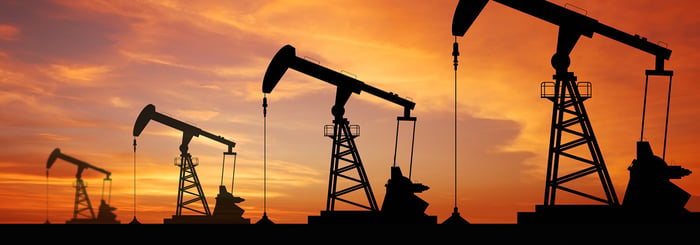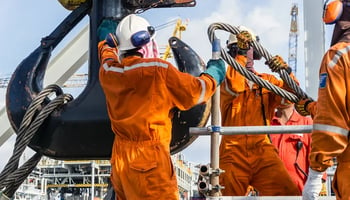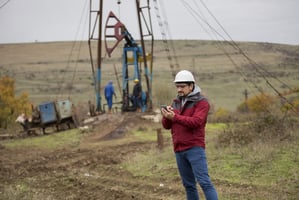Life on an offshore rig or platform can be claustrophobic. Cramped quarters and workspaces are the order of the day. Employees perform their jobs and spend their off time in close proximity. Because of that, there’s practically no privacy, even when someone is ill.
Oil and gas companies have spent billions of dollars drilling for new sources of petroleum and natural gas and building the platforms to extract and produce them. Drilling rigs can be shut down and mothballed during low-price situations, but production platforms must continue to operate as it likely costs too much to close them in the current conditions. As one website bluntly puts it: “It’s almost hard to believe, but it’s actually cheaper for oil producers to pay someone to come and take their crude oil away than it is to shut-in, or close down the well.”
This puts oil and gas companies in a real bind. The crude isn’t worth much right now in a market glut with falling demand, but they have to station enough workers on the platforms to keep them going. In a COVID-19 world, that means placing employees at risk of infection far from shore. Mention “Social Distancing” offshore and you’ll either draw a lot of confused looks or laughs. There’s just no such thing on a platform.
Offshore workers at BP and Chevron have tested positive for the coronavirus. Oil and gas companies have responded by cutting down on personnel offshore and extending rotations. Workers have their temperatures taken and undergo other tests before they are allowed to depart for an assignment. This is part of an effort to stop the spread of the coronavirus.
There's another area oil and gas companies ought to consider when battling against COVID-19 in their offshore workforces. That’s in the onshore MRO warehouse.
An oil and gas MRO warehouse’s role is to receive parts from suppliers, store parts, pick against work orders and ship the parts to waiting engineers and maintenance technicians at the plant or platform. The warehouse takes in parts, materials and supplies from all over the country. This could allow for contamination to slip through.
Many MRO warehouses also use paper forms to receive, track and dispatch goods into, around and out from the facility. In the current COVID-19 pandemic, these paper forms expose warehouse workers to a much greater chance of infection and illness. Recent research in the April 2020 American Journal of Nursing suggests that test organisms were transferred onto paper, survived on it for a considerable time, and were later retransferred to hands, raising the risks of COVID-19 pandemic spread.
Warehouse inventory movements are controlled through an ERP system, such as SAP. Information from these paper forms must be manually inputted into SAP, which means additional handling of potentially contaminated paper. Paper-based systems are also time consuming, error prone, and create a confusion between the physical world and the digital one. This means what’s shown to be on hand in SAP may not be what’s actually in the storage bin. Such a disconnect means needed parts or supplies may be stock outs, resulting in work delays and reorders, or overstocks, which ends in higher inventory carrying and storage costs. It also takes valuable time and effort reconciling the differences between the systems.
Oil and gas companies are looking for greater visibility into their inventory, spare parts and warehouse operations to speed deliveries, reduce costs and minimize downtime. They want a more efficient process that cuts down on errors, increases accuracy and provides a clear picture of their warehouse and last mile process. Finally, in the coronavirus era, they need something that will protect workers from potential infection and illness.
Innovapptive, a mobile-first Connected Workforce platform provider, offers a robust solution that meets all the above requirements. Our mInventory digital solution enables oil and gas MRO warehouses to quickly, efficiently and safely ensure the right parts get sent to the platform so repairs can be made.
mInventory (Watch Video) provides control of the final mile from onshore warehouse to offshore platform by working seamlessly with SAP’s Remote Logistics Management (RLM) module. mInventory provides supply chain decision makers and supervisors the information they need to track parts, equipment and materials.
With mInventory’s mobile-first, digital capabilities, items come into the warehouse and go through each step of the process – from goods receipt to goods dispatch – with no paper required. No paper putaway slips, picking slips, packing slips … everything is electronic. There’s nothing to manually input, either onto a form or into the system of record, such as SAP. This keeps warehouse staff away from paper and from one source of potential infection.
Instead, warehouse workers armed with mobile devices such as smartphones, tablets, scanners, wearables, etc., scan incoming items’ barcodes or use optical character recognition (OCR) technology to read information and assign storage bins. Likewise, when an item is needed to ship to a platform or other facility, goods can be located, picked, packaged and dispatched electronically. Once the item is sent, mInventory works with RLM to give greater control over the outbound process. At each step, decision makers have immediate, real-time access to data via mobile applications. mInventory:
- Eliminates manual, paper-dependent processes.
- Increases efficiency and reduces risks of COVID-19 infection.
- Minimizes overtime costs.
- Accelerates warehouse goods receipt, putaway, picking, packing and dispatch.
- Tracks and manages oil and gas inventories with real-time accuracy.
- Provides field technicians with access to crucial inventory information.
- Lowers inventory carrying costs.
To learn more about how mInventory’s RLM capabilities can provide greater employee safety in today’s COVID-19 pandemic, higher inventory accuracy and additional warehouse efficiency, schedule a free demo today by calling 844-464-6668 or by clicking here.




